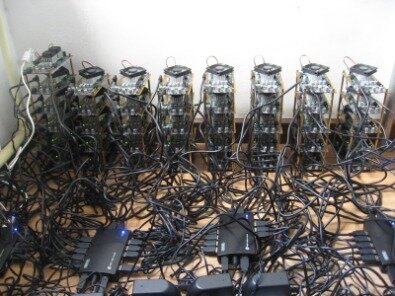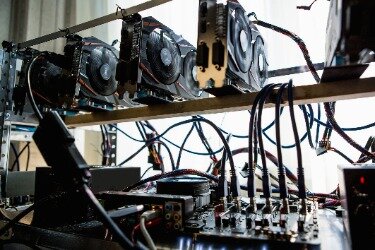How To Mine Cryptocurrency With Raspberry Pi
Content
- Most Powerful Hardware
- What Is Illicit Cryptocurrency Mining?
- Alternatives To Nicehash
- 3 Estimation Of The Energy Costs Of Bitcoin Mining
To do this, they bundle up transactions into so-called “blocks.” They then have to solve a computational problem called “proof of work,” which assigns the block an identifying code. The Bitcoin network shares a public ledger called the “blockchain.” This ledger contains every transaction processed, which allows the user’s computer to verify the validity of each transaction. Digital signatures corresponding to addresses confirm the authenticity of each transaction. That means users have full control over sending Bitcoins from their own addresses. For most users, Bitcoin is nothing more than a mobile app or computer program. However, behind the scenes, the technology that supports the asset is incredibly powerful. The core of this technology is the Bitcoin mining network.
If you are ready to convert your cryptocurrencies to hard cash, head over to the menu at the top left of the MinerGate app. From here, you can view your exact balance for all mined cryptocurrencies. The MinerGate app has a very useful chat feature, which allows you to get in touch with more experienced users. This can be very helpful if you need assistance working out which cryptocurrency to mine and/or whether you can do so profitably on your Android smartphone. To mine cryptocurrency with the MinerGate app, you need a compatible device.
It is also deathly cold, which cuts the cost of ventilating and cooling its mining kit as it heats up. Get effective protection against cryptocurrency mining with ESET multilayered endpoint security solutions. Detect potentially unwanted cryptomining scripts, cryptomining Trojan horses and benefit from a Ransomware Shield and LiveGrid® protection via the cloud and network attack protection.
BITCOIN mining machines worth more than £40 million have been shipped to Russia as part of a major new operation launched by mysterious backers, according to industry insiders. 67% of retail clients lose money when trading CFDs with this provider. The state of mining affects each coin’s decentralised state, reliability and value. That’s why it’s important to understand the concept of mining and whether this is something you might consider doing.

On a blockchain , transactions are governed democratically. It means that you can’t transact without each transaction being verified by multiple parties on the network. Figure 6 reports the ratio between the daily mining cost Ct and daily transaction volume Vt.
This verification process is fundamental to the integrity of Bitcoin, as it avoids the issue of ‘double spending’ – where individuals would try and initiate multiple transactions using the same bitcoin. The lower bound of the total energy costs of Bitcoin mining is estimated as the minimum energy cost of each hash multiplied by the total number of hashes computed over a given period of time . Figure 4 reports the total mining daily cost in USD estimated by using Equation , it varies from around 3 USD a day in 2010 to over 4 million USD a day in early 2020. Note that this is the lower bound estimate and the actual cost is presumably much larger. The growth in mining costs is affected by both the changes in energy cost and by the increase in the hashing rate in the Bitcoin network . We note that the variations in energy cost oscillates in a much narrow band with respect to the changes in the daily number of hashes and therefore, the minimum Bitcoin mining costs mostly mirrors the growth in the total number of hashes.
Gas-powered blockchain systems require developers to attach gas to a transaction. That gas will supply the computational power until the transaction is validated or until the gas runs out. This is considered as a safer way for miners to contribute to solving new blocks. By doing so, the risk of wasting unnecessary computational energy is eliminated and miners can maintain the blockchain in a more quick and efficient manner. In order to encrypt the block, miners have to solve a complicated cryptographic puzzle in order to find the cryptographic hash that’s proper for the block.
Most Powerful Hardware
Certainly a combination of both old and new mining hardware should coexist in the Bitcoin network as long as each machine continue to generate a profit. However, the market share of each hardware and its evolution over time is an unknown. With respect to the purpose of the present estimate of the lower bound of the mining cost, we must stress that the maintenance and the hardware costs must be anyway proportional to the energy consumption costs. By ignoring them we are under-estimating the total mining cost by some factor but, beside this factor, the estimation of the overall behavior of the mining cost should not be significantly affected.

This has reduced energy cost per hash by about thirty thousand times during the last 10 years. However, the miners in the Bitcoin network are presently computing nearly 1025 hashes per day, up over 10 orders of magnitude from the 2010 levels.
What Is Illicit Cryptocurrency Mining?
In Iceland, meanwhile, Genesis Mining, led by chief executive Marco Streng, has been harnessing the northern nation’s geothermal energy to power its data centres. According to Digiconomist, around 77 terawatt hours of electricity annually are needed by the Bitcoin network, roughly the electricity used by Chile, emitting 37 megatons of carbon, the same as New Zealand. It could be done in a bedroom with a graphics-processing computer. There were almost no Bitcoin miners out there, so early miners were able to mint thousands of coins.
Cryptocurrencies hold a risk of losing their value which automatically turns your mining activities into a non-profitable investment. Regardless of what happens, though, the high-end computers and equipment miners use hold their value very well. This means that if you decide to quit the market or the cryptocurrency you were working to mine suddenly crashes, you would still have value in the equipment you used to mine the currency.
One more thing has become an issue when it comes to mining. Profitable organisations and institutions started investing a substantial amount of money for efficient hardware. Not just that but they moved their mining rigs to dams and countries where electric power supply is less expensive. The process is called “mining” because it involves volunteers contribute to the blockchain development with a great deal of effort in the hopes of getting a reward. It only makes sense that miners are contributing to blockchains because of the potential profit.
While Google hasn’t specified the reasons for delisting the crypto mining apps, we can assume they did so because of the same reasons, that is, to prevent the devices from overheating and damaging the hardware. To make matters worse (from a miner’s perspective), the ‘difficulty’ of the competition increases as more miners get involved; this is done to avoid issuing new bitcoins too quickly. The block reward also halves every four years, making them much more expensive to produce.
Finally, an attack involving a large fraction of the Bitcoin volume would be most likely detected by the network before its completion. A mining hardware has an energy consumption that can be measured in joules per terahash (J/Th), and has a hashing speed that can be measured in terahashes per second (Th/s). For the purpose of estimating a lower bound to the energy costs of Bitcoin mining, we considered at any point in time that the entire network is adopting the most energy efficient machine available at that time. For the purpose of this study, we focus only on the first element, the energy cost of running the Bitcoin mining hardware which is likely to be the key driver and is the only cost that can be estimated with some precision.
Alternatives To Nicehash
In the case of Bitcoin, the transactions in the new proposed block and the header of the most recent block is inputted into the SHA-256 hash algorithm, making therefore a chain with unique direction. Such a chain is at the heart of the Bitcoin security because it makes it difficult to alter the content of a block once subsequent blocks are added to the chain. In Bitcoin, this cryptographic sealing process through a hash chain is intentionally designed to be computationally intensive by accepting hashes only if the randomly generated hash number is smaller than a given target. Therefore the community performs a large number of hashing by modifying a random component of the block content until, by chance, someone finds a “valid” hash that is smaller than the threshold. This is called proof of work and serves the purpose to determine majority consensus.
The process starts with the blockchain, where all Bitcoin transactions are recorded. Each time a trade is made through a cryptocurrency trading platform, the transaction details are broadcast to Bitcoin miners. The miners compete to mine crypto, but they’re also there to help dependently verify and record every transaction made. While POW seems to be favouring the biggest hardware rigs, newer schemes like Proof of Stake are already making a statement that reward miners based on a different set of factors. In Iceland and Norway, where nearly 100 per cent of all energy production is renewable, cryptocurrency miners are taking advantage of cheap hydro-electric and geothermal energy to power their machines.
Users who are able to triumphantly generate the correct 64-digit hexadecimal number, or ‘hash’, which is either less than or equal to the target hash associated with the block, are then remunerated with Bitcoin. The complexity behind creating Bitcoins all stems from its blockchain. This public ledger is designed to support the activities of Bitcoin and record every single transaction across its network. For a full guide on how blockchains work, head over to our explainer.
These are formidable changes to a scale never observed in financial systems or in human activity in general. Over the last few years we have received an increasing number of enquiries for the cooling of cryptocurrency mining facilities and the miners that they house. The cryptocurrency market is growing rapidly and miners are now buying up large facilities in remote locations to run their facilities. These remote locations include Northern Sweden and The Arctic Circle. In these locations, free cooling can be expolited the majority of the time and renewable, cheap power is available to run facilities. We are also seeing an increase in smaller facilities based in the UK and other European countries, where operators are looking at building up facilities in warehousing or repurposed buildings. As the requirements for mining are similar to that of HPC data centre cooling we have developed a modular cooling system which can be designed and installed simply to provide cool air to the miners.
Your wallet will control various ‘addresses’, which, like bank account numbers, can be used to receive bitcoins. It will also control the secret password that is needed to authorise the sending of bitcoins .
If we limit our analysis to the last period after the end of 2017, we obtain a mean ratio of 0.3% and D1, D10 deciles with values equal to 0.1 and 0.4%. Regional share of hash rate and electricity prices were not available for USA or Russia so similar adjustments weren’t possible. Due to these other factors and the lack of historic data on electricity prices in several other countries around the world, the majority of this paper will focus on energy pricing using the Brent Crude oil index. A comparison of ratio between the cost of mining and Bitcoin transaction volume is presented in Figure 6 to show the standardized oil prices as a measure of energy cost yield similar results to using regional electricity prices. The network incentivizes users to participate in the block validation process by assigning newly mined Bitcoins to the first user who randomly finds a hash with a value smaller than the threshold. Presently, after the latest Bitcoin halving, this remuneration is 6.25 Bitcoins or around USD 60,000 at the current exchange rate . For this reason, the hashing process is called “mining” and miners often join to form large mining pools to have a more stable source of income (Gervais et al., 2014).

Each bit of hardware isrigorously tested before reaching you and also comes fully PAT tested and with all of your relevant mining accounts set up. Monitor company systems for excessive power usage or other energy consumption anomalies that might point to unsolicited cryptomining activity. Cryptocurrency miners expose vulnerabilities in an organization’s cybersecurity, which can lead to severe compromises and disruptions.
Like a share or a house, bitcoins are worth nothing more or less than what other people are prepared to pay for them. In the early days Bitcoin traded for $1 per bitcoin; it peaked at around $20,000 (£15,400) in 2017 before plunging to around $3,000 (£2,300) then settling around $8,000 (£6,200). The supply of bitcoins is carefully controlled and limited, and no one can create or issue more bitcoins at will. There will never be more than 21 million bitcoins; and each bitcoin is itself divisible into 100 million units known as Satoshis.
- After the initial investment in the hardware, there are running costs to Bitcoin mining.
- So instead of borrowing a supercomputer, malware writers hijack the processor in your mobile phone and use them to mine crypto.
- The mining pool company , also charges a small commission on your transactions.
- A mining hardware has an energy consumption that can be measured in joules per terahash (J/Th), and has a hashing speed that can be measured in terahashes per second (Th/s).
Mining also secures the network the coin operates on by verifying transactions. If bitcoin’s transition to renewable energy sources does not happen quickly, Hoskinson is among several experts who predict that investors and consumers will look to other cryptocurrencies that are less environmentally damaging. Alternative cryptocurrencies have also sought to solve bitcoin’s current environmental issues by altering the underpinning technology in order for it to require less power. Bitcoin miners therefore gravitate to where electricity is cheapest, meaning the fundamental issue is not with bitcoin but with a lack of cheap renewable energy production. The amount of energy bitcoin’s network consumes did not rise to serious prominence until 2017, when a major price rally drastically pushed up its energy needs to the level of a small country.
Cryptocurrency Mining Power Generation
This cost is not borne by either the sender nor the receiver in a transaction but rather by the miners. While a billion a year burned in hashing is definitely a large amount of money that could be seen as a waste of resources, the Bitcoin proof of work is a necessary process for such an anonymous permission-less network to function. It is indeed required to validate transactions and obtain community consensus to secure the system from attacks. We could therefore conclude that in the Bitcoin network the cost of proof of work is not at all too high.



